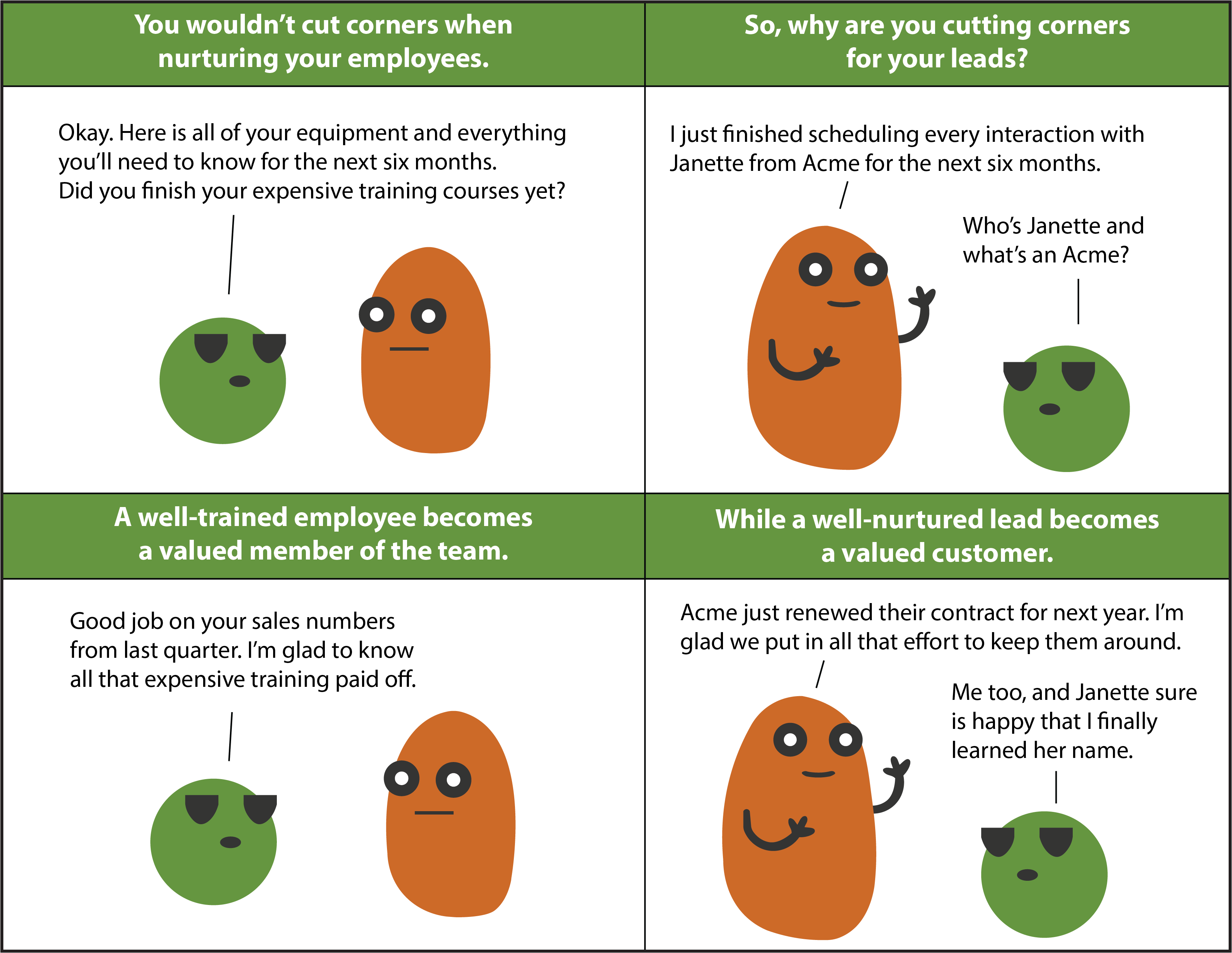7 Manufacturing Lead Generation Tips – Treat Your Prospecting The Same Way You Would a New-Hire

The Bureau of Labor Statistics released two intriguing statistics about employee turnover:
No business wants high turnover but what does that have to do with sales and marketing in the manufacturing and industrial space? We have been noticing some interesting parallels between HR and sales-marketing alignment in this respect. Specifically, we’re comparing what companies do to nurture and develop employees (to avoid turnover) with what you should do to nurture and develop prospects (and not lose opportunities). A statistic you may have seen before is that 79 percent of leads never convert (based on research by MarketingSherpa). Yikes!
We can all agree that whether we’re talking about new hires or leads, turnover or lost opportunities, we want to do whatever we can to achieve success. The Society for Human Resource Management (SHRM) says “employers [should] take steps to understand the needs, preferences and goals of their employees,” but we think you can easily replace “employees” with “qualified prospects or leads.”
Unfortunately, most of us probably know what it’s like to have a manager or supervisor who lacked the ability to help us develop as an employee. The best recruiters and managers support new hires with useful information and keep in touch over time to help them reach their potential (and continue to work there). In sales and marketing the same concepts apply: the more aligned, coordinated sales and marketing teams are with prospects, the better progress a lead will make through the sales cycle.

Our suggestion is to treat your leads like new hires! Think about it: if you were a hiring manager or supervisor, you would never skip critical HR tasks like onboarding, training, or performance reviews. Once you see the parallels with the progression of a lead through the sales and marketing funnel, you’ll never leave them out of your sales processes again either. Here’s our take on it:
1. Recruiting, writing clear job descriptions, attracting candidates and putting your best organizational foot forward.
Recruiting is comparable to using inbound marketing tactics such as blog posts, eBooks, and social media to make yourself “findable” via online searches. Your content can establish you as an expert in your portion of the manufacturing/industrial market and entice prospects to do business with you or at least learn more about what you offer. Rather than general, blanket content, target your ideal candidate customers with material that addresses their perspective and pain points. Marketing may create much of this content, but sales should regularly contribute topics and feedback based on their conversations with prospects. By working together your message stays consistent and both teams will know what information is available to distribute.
You’d never hire the first person who walked in your door without an interview, and leads are the same. Take time to qualify leads through detailed discussion that draws out pain points. During the vetting process, sales can use rejection handling techniques based on market research and past experience. It’s also critical to listen closely to answers for clues to future opportunities and assess the fit between their needs and your offerings. Sounds a lot like hiring, doesn’t it?
This is when a new hire becomes “official” by filling out standard forms and signing documents. In the B2B sales world it’s when marketing hands off their leads to sales. In order to avoid misunderstandings and meet expectations, it’s critical for marketing and sales to agree on definitions of key concepts like SQL (sales qualified lead) and MQL (marketing qualified lead), as well as schedules for nurturing and follow up. Because both teams often work in a shared CRM or marketing automation tool, it’s important that everyone understands how to use task reminders, update records, and that they share any unique circumstances about a particular lead. And finally, once you’ve gone through the work of defining terms, agreeing on responsibilities, and nurturing processes, be sure to create (and share) official documentation!
Just as a supervisor guides a new hire, making sure they understand their role and get the training they need, leads need guidance through the funnel. It starts by following up on every qualified lead marketing passes along, developing rapport and building trust. Marketing can help sales by communicating any special circumstances and creating content tailored to new audiences they discover. Tracking a lead’s engagement with online content and the number of touches via phone or email and using that data to plan nurturing ensures they don’t get lost in the shuffle. And then there’s making sure all members of the team are trained on using the CRM, marketing automation platform, dashboards, and metrics to keep information organized and set priorities.
Managers know their employees’ lives are about more than just their jobs, and sales reps are wise to remember behind every lead is a person (or buying committee) who appreciates good, relatable conversation. Stay top-of-mind by contacting leads regularly but take time to develop rapport, remember details about them and their situation, and just getting to know them individually. A hard sell is usually a turn off, so find ways to keep leads engaged with new marketing content, genuine questions about their company, or a simple friendly greeting. It is vitally important to find out what motivates and affects your prospect.
Most employees appreciate the chance for feedback and even a little constructive criticism. The progress of a lead is not always a straight line from prospect to closing, so it’s worth taking time to evaluate how the sales cycle has been going and course correct if necessary. Recap your last sales call with the lead to verify your understanding, answer technical questions in a timely manner, and bring up the things that set you apart and why that is significant to the prospect’s needs. It all shows you’ve been paying attention.
Internally, marketing and sales should hold regular meetings to see what processes are working, what needs clarification, and to swap ideas for messaging and talking points. Tap into the power of marketing automation platforms like HubSpot to analyze how prospects and leads interact with your content (i.e. opens, clicks, downloads) and plan your next steps too. Your sales and marketing process, just like your HR processes, are an ever evolving and continuous refinement is just a matter of course.
No one enjoys this part of a job interview, but it’s best to share expectations and limitations up front. Of course, you can’t always give a customer exactly what they request, but your openness to discuss their budget, schedule, and other factors builds trust and shows you’re serious about doing what it takes to make them a customer. Leverage the value-added things you bring to the table and any incentives you can offer, from planned maintenance to site visits, to discounts. If you’ve done the work to nurture and build a relationship, you won’t need to fear asking and answering tough questions.
Now that we’ve made the case for treating your leads like new hires (and possibly given you some employee development food for thought too!) we hope you’ll give it a try. Let us know how it works out – we’re always here to help.
Feel free to contact us if you would like to chat further about your business development needs.
Comments